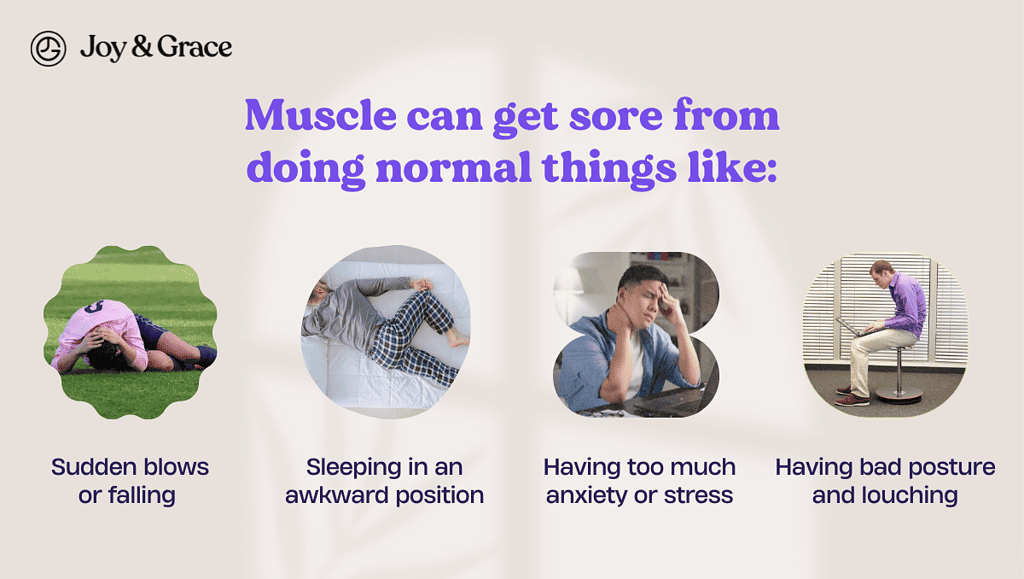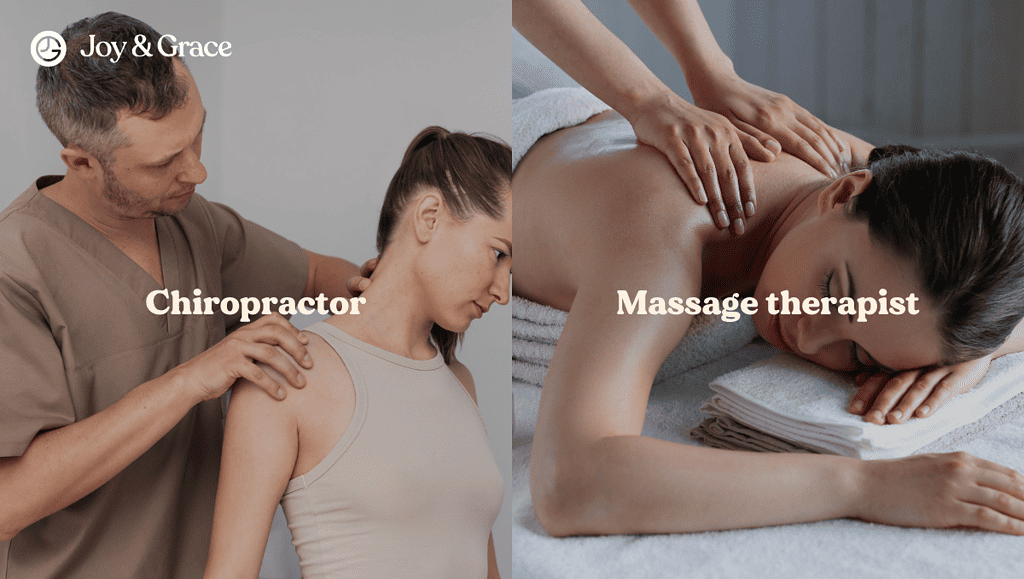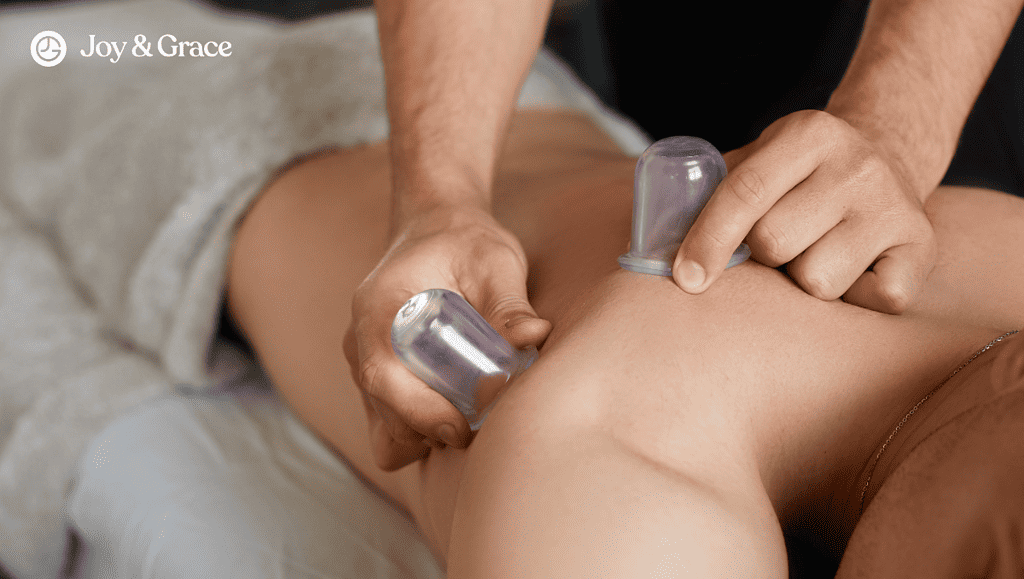Many things can cause neck pain, such as bad posture, muscle strain, or an injury. The American Physical Therapy Association found that about half of all adults will have neck pain in a given year.
There are a lot of different ways to deal with neck pain. It can be hard to figure out which is best for you. People often choose chiropractic care and massage therapy. But each one has its own pros and cons.
This article will compare and contrast chiropractic care and massage therapy for neck pain to help you decide which is best.
Is A Chiropractor Good For Neck And Shoulder Pain?

Chiropractors try to figure out what's wrong with the bones, muscles, and joints and treat them. In their line of work, treatment is mostly done by manually adjusting and/or moving the spine.
Chiropractors want their patients to feel less pain and live better lives. They are trained to suggest activities and give advice on nutrition, diet, and way of life.
Most people think of chiropractic care as an alternative form of medicine. Chiropractors do not give out pain medication. They instead believe that the body has the power to heal itself.
After lower back and neck pain, shoulder pain is the third most common complaint unrelated to the spine. A study found that the combination of joint mobilization and exercise is effective in treating shoulder pain. This type of approach targets sore, stiff, or compromised joints to improve their function.
Joint mobilizations may increase the range of motion, ease pain, and lessen stiffness. During joint mobilization, the chiropractor keeps one part of a joint still while pushing on the area next to it. Depending on the technique, the force applied can be more gentle and slow or more powerful and sudden.
Chiropractors may be able to help people with neck pain by making manual adjustments. This is when a chiropractor uses their hands to adjust the cervical spine (neck).

There are two main ways to make manual adjustments:
- Spinal manipulation. Spinal manipulation is also known as chiropractic adjustments. Spinal manipulation aims to improve the joint’s function, increase its range of motion, and reduce pain.
When spine manipulation is done, it usually makes a sound like cracking or popping. Some people say they feel relieved or enjoy the cracking sound, while others don't.
- Spinal mobilization. In this type of manual adjustment, the chiropractor moves spinal joints slowly through their natural ranges of motion.
The practitioner's hands gently move and stretch each level of the spine that is being worked on. Most of the time, spinal mobilization does not make a cracking sound.
According to a study, spine mobilization and spine manipulation are effective for treating neck pain.
Other studies state that spinal manipulation may be helpful for acute neck pain or pain lasting less than 6 weeks. Meanwhile, either spinal manipulation or mobilization may be helpful for chronic neck pain.
There may be side effects after treatment. These effects may occur more often after spine manipulation than during spine mobilization. According to a study, the most common symptoms are increased neck pain or stiffness, but patients say that the pain goes away over time.
Side effects happen often, but most of the time, they aren’t very bad. Most of the patients say that they are getting better, especially over time. So, it seems that chiropractic care for neck pain may have more benefits than risks.
Can A Chiropractor Help With A Stiff Neck?
A chiropractor might be able to help with a stiff neck, especially if the pain is sudden or only lasts for a short time. If there are other symptoms along with the stiff neck, chiropractors may need to do more tests. This is done to figure out if chiropractic care is a good way to treat the problem.
A stiff neck often hurts and makes it hard to move the neck, especially when trying to turn the head to the side. If your neck is stiff, you might have to turn your whole body to look to the side or over your shoulder.
Usually, a muscle strain or soft tissue sprain is to blame for a stiff neck. The levator scapulae muscle, which is located at the back and side of the neck, is often to blame. This muscle can get sore from doing normal things like:

- Sudden blows or falling that push the head to the side (such as injuries due to sports)
- Sleeping in an awkward position
- Having too much anxiety or stress
- Having bad posture and slouching while looking at a computer screen or mobile phone for long periods of time
The activities above may cause acute neck pain. As time progresses, the condition may become subacute or chronic.
According to a study, people with acute neck pain improved while under chiropractic care. There were also no reported adverse reactions.
Chiropractors should evaluate patients with neck pain complaints for potential red flags. In an article about chiropractic care, these warning signs are listed as follows:
- History of a connective tissue disease
- Osteopenia, or the loss of bone mineral density
- Trauma or infection
- Unexplained neck pain, especially for ages below 20 or greater than 55
- Cancer
- Unexplained weight loss
- Change in consciousness
- Severe night/nocturnal pain
- Disturbances in vision or speech
- Weakness
- Loss of sensation
- With a fever greater than 100°F
These conditions suggest that there may be a serious underlying illness. If this is the case, health professionals may need to do more testing, make referrals, or work together to help the person. These extra steps help figure out if chiropractic care is the best way to get rid of the pain.
What Kind Of Massage Is Good For Neck And Shoulder Pain?

Massage therapy, on the other hand, focuses on the muscles and soft tissues instead of the bones. Lotions and oils are used in massages to ease muscle pain, stiffness, and tension.
Massage therapists try to get rid of pain and stress. By massaging the muscles, a therapist can help get more blood to the injured area, which speeds up the healing process.
There are many different kinds of massage, each with its own techniques, strokes, and ways of applying pressure with the hands or other tools. A good massage therapist knows how to work on the specific muscles in the neck or shoulders that are causing pain.
In massage therapy, techniques are used to get more blood to the muscles and relax them. This could make the pain in your neck and shoulders go away.
Here are six types of massage that are often used to treat neck and shoulder pain:
- Deep tissue massage. This massage uses slow, deep strokes with steady pressure to reach deeper into the muscle tissue. It can help relieve chronic pain or get rid of knots in the muscles. It may also help the body heal faster by increasing blood flow and lowering inflammation.
- Swedish massage or soft tissue massage. Soft tissue massage is a technique that is less invasive than deep tissue massage. Swedish massage uses a variety of techniques, such as long, circular strokes, kneading, and passive joint movements.
As compared to deep tissue massage, Swedish massage is much gentler and more suitable for people who want to relax and relieve tension.
- Trigger point massage. A tight knot in muscle tissue that can cause pain is called a trigger point. Trigger points can be caused by strain, injury to muscle fibers, repetitive motion, or not moving your muscles for a long time. The upper trapezius muscle, or the muscle found on either side of the neck just above the shoulders, is a common place to find trigger points.
A trigger point massage targets the tight muscle knots in your body, helping to soothe the tightness and provide pain relief. You may also perform a trigger point massage using your hands or with the help of tools such as foam rollers, massage guns, and tennis balls.
- Myofascial release. The main focus of myofascial massage therapy is on the myofascial parts of the body. "Myo" means "muscles," and "fascia" is the stiff, elastic, and thin connective tissue that covers many body parts, including muscles.
The myofascial area should be flexible most of the time, but it can get stiff and make it hard to move. In myofascial release therapy, the therapist focuses more on the release of tension in your fascial tissues.
The therapist can loosen up these tight and stiff areas by focusing on stretching and applying pressure by hand. This helps reduce pain and improve the range of motion.
- Hot stone massage. In hot stone massage, heated stones are added to a Swedish massage. During the massage, smooth, flat, heated stones are placed on specific parts of your body, such as your back, neck, arms, and legs. Most of the stones used in this type of massage are made of basalt, which is a type of volcanic rock that holds heat.
Can A Massage Make Neck Pain Worse?
Massage has been shown to help many people with neck pain, but it can sometimes make the pain worse.
In some cases, the wrong kind of massage can make the muscles tighten, which can increase pain levels. Also, if the massage techniques are too rough, they can irritate and inflame the neck, making the pain worse.
This section will show the side effects and possible harms of massage therapy that you should know about.
What Are The Side Effects Of Massage Therapy?

Massage therapy can have different side effects, depending on the type of massage and how it is done.
Massage therapy is generally safe and can be good for the body and mind. However, there are a few possible side effects that should be taken into account when dealing with neck pain:
- Fatigue. Since a massage gets into the top layers of your muscles, it will make your muscles feel a little sore afterward. The muscles will then feel relaxed, which could make you tired or hurt your muscles.
- Lingering pain. Due to the amount of pressure used, massages, especially deep tissue massages, can cause pain that lasts for a while.
- Headaches. Your headache may be caused by your head placement during the massage or by the massage of other affected areas, such as your neck or upper back. A headache may result when the muscles around your head release the tension or pressure from the massage.
- Sleepiness. Because the massage releases tension, most people feel sleepy or tired afterward. But you shouldn't feel like this for more than a night after your massage.
- Redness on the skin and a feeling of heat. These side effects may happen because the pressure is intentionally applied during a massage. The sensation of heat may also be an indication that the treated muscles are responding well and beginning to heal.
What Are The Possible Harms Of Massage Therapy?
Most people think of massage therapy as a safe treatment, but things can sometimes turn out worse than expected.
Serious injuries are rare in massage therapy. The number of less serious injuries reported in medical journals is likely higher than the number of serious ones. But it's still important to be aware of the ways massage therapy could hurt you.
Here are some case studies that show how massage therapy can be dangerous:
1. Creating new injuries
a. Damages to blood vessels
In a case report, a 59-year-old man who had 2 hours of deep tissue massage got a hematoma in his left buttock.
A hematoma is a pool of mostly clotted blood that forms in body tissue or organs. Most hematomas are caused by a broken blood vessel.
After many tests, it was found that he had a damaged artery in the superior gluteal artery, which supplies the buttocks.
In another case report, a 30-year-old man got a headache, threw up, had trouble seeing, and couldn’t control his muscles after getting a neck massage. It was found that the massage had hurt an artery in his neck.
Normally, blood vessels like arteries and arterioles are elastic, but as people age, they get stiffer. When blood vessels are pushed too hard from the outside, like during a deep tissue massage, they can also break.
It's important to think about a patient's vascular system when choosing massage techniques for them. Massage therapists should also think about how weak their client's blood vessels may be.
b. Hearing problems
There are also reports of a few people who lost hearing after getting a massage. These people had neck pain and were told to get massages. After the massage, they noticed a sharp loss of hearing. Based on the order of events, it is likely that there is a causal relationship between getting a massage and experiencing hearing loss.
c. Intestinal injury
One case report was about a 68-year-old man who had a habit of massaging his stomach to get rid of constipation. Later on, he had an attack of sudden stomach pain. The results of the surgery showed that there was a hematoma the size of a fist in the abdomen, along with a lot of bleeding. In addition, there was a cut in his upper colon, around 5 centimeters.
People have said that abdominal massage is effective and safe for getting rid of constipation, but this case shows that it could be harmful. Even though it happens very rarely, it's important to keep this scenario in mind.
2. Worsening existing injuries and problems with chronic pain
In another case report, a 43-year-old man who got a neck massage ended up with tetraplegia. Tetraplegia is damage to the spinal cord that makes it impossible to move the upper and lower bodies. Usually, it affects the fingers, hands, arms, chest, legs, feet, and toes.
The patient got a massage because of pain in his neck and shoulders. During the massage, he felt paralyzed in the area of his right upper and lower limbs.
In the evening of the same day, the patient felt weakness all over his body, so he went to the emergency room of a hospital. Doctors found out that he had a spinal cord injury after his massage.
Many places offer massage therapy because it is thought to be a fairly safe method. But people should know that massage therapy can cause problems that need extra care.
Even if it's something minor, massage therapists should be aware of their client's risk factors for injury.
3. Causing mild stress to the nervous system
Massage therapy should be done carefully so that it doesn't cause more problems.
In one case report, a 61-year-old man went to a clinic because his right hand felt tingly and numb. A month ago, he got a massage on the end of his forearm to help relieve the pain in his right finger.
After the massage, he told the therapist that his right hand was feeling weird and that he didn't like it. The therapist said that over time, it would get better.
After a week, the man came back to get a massage in the same area. After the massage, the man's symptoms got worse, so he went to see a doctor. It was found that his right hand's median nerve had gotten swollen.
Most nerves can take a lot of pressure without getting hurt, but they're still sensitive. If you push too hard in the wrong place, you can hurt a nerve.
4. Causing rhabdomyolysis
Deep tissue massage may actually make things worse instead of better. This case may be one of the rare yet serious complications of massage therapy:
A 44-year-old man came to a hospital complaining of muscle pain in the upper limbs. About 2 days before, he had an upper body massage that lasted somewhere between 30 and 60 minutes.
He went to the hospital when his symptoms got worse the next day, and his urine was dark brown when he woke up. He had a condition called rhabdomyolysis.
Rhabdomyolysis is also called "muscle crush injury.” It is a rare condition in which torn muscle fibers release a substance into the blood that can lead to problems like kidney failure.
It is very likely that the massage caused his condition. During the massage, the therapist could have applied too much pressure and torn the muscle fibers.
5. Preventing patients from getting appropriate health care
A lot of patients choose massage therapy over medical care. Many massage therapists go along with it and miss the significance of the patient’s symptoms by relating them to “tense muscles” or “toxins.”
A lot of what massage therapists believe isn’t supported by science. As with any alternative medicine, massage therapy can be most dangerous if the symptoms are misdiagnosed.
What Do Other Studies Say About Massage Therapy For Neck Pain?
Aside from case studies, there are also other research studies related to massage therapy and neck pain. These studies have different results on how well massage therapy works for chronic neck pain and stiffness.
A study on how therapeutic massage affects neck pain found that getting a massage is safe and may help treat short-term chronic neck pain.
The research shows that massage helps with neck pain and makes it easier to move. It's helpful, especially when done a few times a week for a few weeks by a trained professional. Most of the time, though, these effects don't last very long.
In contrast to what other studies have found, this one found no evidence that massage therapy helps with neck pain.
Another study shows that getting a massage may make a person's neck pain worse, especially if they have signs of depression.
More research is needed to find out if massage can help with chronic neck pain and stiffness and if the effects can last. Even though the benefits of massage may only last for a short time, it may still help with pain and make life better.
How Do You Massage Your Own Neck For Pain?
Even at home, you can still massage your own neck to ease the pain and discomfort if your neck is feeling stiff and sore.
Here are some tips on how to massage your own neck if you need help right away.
- Stretch the back of your neck by tucking your chin into your chest.
- Stand tall with your feet shoulder-width apart and your arms at your sides. Inhale deeply and lower your chin. Hold for 5 slow counts while exhaling, and then return your head upright.
- Practice this stretch at least five times a day or whenever you feel tense.
- Stand tall with your feet shoulder-width apart and your arms at your sides. Inhale deeply and lower your chin. Hold for 5 slow counts while exhaling, and then return your head upright.
- Put the tips of your fingers on the back of your neck on both hands.
- Make sure you reach all the way to the suboccipital area or where your head meets your neck. These muscles are very important, and they can give you a headache if they are tight.
- With light to medium pressure, use circular motions with your fingers and move up and down the area. Do this for around 30 to 60 seconds or until the tension starts to go away. You may add lotion or cream to help with the massage.
- Move your fingers down along each side of your spine. Once you reach the spine at the back of your neck, move your fingers from ½ inch to an inch outwards.
- Use medium to deep pressure, starting from the base of your skull. Slide your fingers down until you reach the area where your neck meets your shoulders.
- If you feel any knots as you move your fingers, press gently on them for at least 10 seconds or until you feel them loosen.
- Use medium to deep pressure, starting from the base of your skull. Slide your fingers down until you reach the area where your neck meets your shoulders.
- Put your right palm on the back of your neck. Wrap your fingers around your neck so that they all point in the same direction (including your thumb). Then, tighten your grip on your neck and turn your head to the left. Hold this position for one deep inhale and exhale before bringing your head back to the middle. Tighten the grip of your right hand again, and then turn your head to the right. Hold this position for one deep breath.
- Repeat the same action, but this time place your left hand on the back of your neck.
- Do this massage technique five to seven times on each side.
- Repeat the same action, but this time place your left hand on the back of your neck.
Once you've finished massaging your neck, you can apply a little bit of heat. Heat is a great way to relax tense (and possibly inflamed) muscles, and it can help you sleep better.
Should I See A Chiropractor Or Massage Therapist For Shoulder Pain?
Shoulder pain comes in many forms. The best way to treat this condition depends on what’s causing it. Both chiropractic care and massage therapy help people with shoulder pain and mobility issues.
If your shoulder pain is due to a muscle strain or other soft tissue injury, you may find relief with massage therapy.
Massages can help to increase blood flow and reduce inflammation, which can speed up the healing process. However, massage therapy may not be suitable for everyone, as some people may find it too painful or uncomfortable.
It is also important to remember that massage therapy may come with side effects and possible harm if done wrong.
A study shows that massage therapy helps improve the shoulder's range of motion, especially when it comes to abduction and flexion. Massage therapy is a good technique to help muscles relax, get more endorphins, ease muscle tension, and get more blood flowing.
If your shoulder pain is due to a misaligned joint, you may find relief with chiropractic adjustments. Adjustments from a chiropractor can help put the joints back in place and take pressure off the muscles and tissues around them.
A study confirms that chiropractic care for frozen shoulders improves mobility and function. The results indicate that most people with shoulder pain who get chiropractic adjustments feel a lot less pain. They can also move their affected upper limbs more.
Takeaway
Chiropractors and massage therapists can both be useful in treating pain, but they use different techniques to do so.
A chiropractor’s treatment revolves around spinal adjustments. Meanwhile, a massage therapist focuses on applying pressure to the muscles to provide pain relief.
You may have several treatment options if you have neck or shoulder pain. The ideal treatment approach for neck discomfort is customized to the individual. It is important to choose the proper one for your condition.
When visiting these practitioners, keep an open mind and be honest about your neck pain. Tell the practitioner what has helped you in the past and what hasn't so they can make a treatment plan that works for you.
Now that you know what the differences are between the two fields, you can decide which type of specialist is best for your condition.















